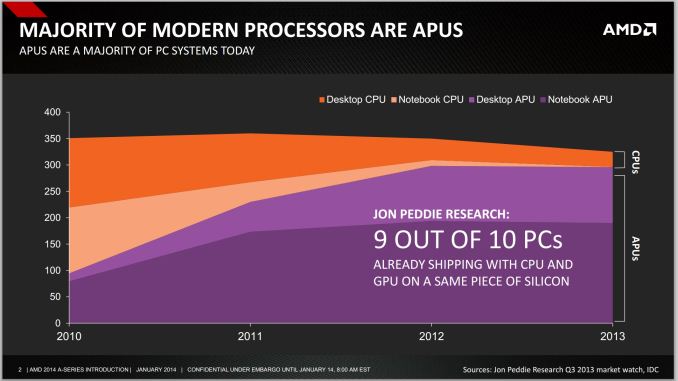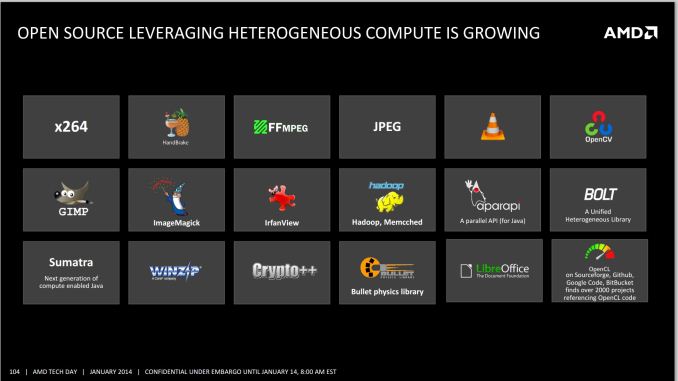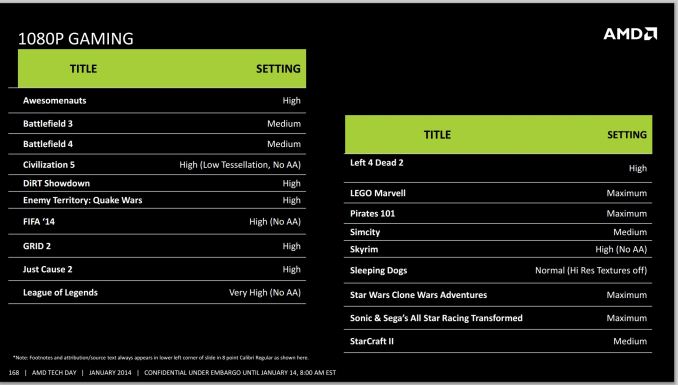AMD Kaveri Review: A8-7600 and A10-7850K Tested
by Ian Cutress & Rahul Garg on January 14, 2014 8:00 AM ESTKaveri: Aiming for 1080p30 and Compute
The numerical differences between Kaveri and Richland are easy enough to rattle off – later in the review we will be discussing these in depth – but at a high level AMD is aiming for a middle ground between the desktop model (CPU + discrete graphics) and Apple’s Mac Pro dream (offloading compute onto different discrete graphics cards) by doing the dream on a single processor. At AMD’s Kaveri tech day the following graph was thrown in front of journalists worldwide:
With Intel now on board, processor graphics is a big deal. You can argue whether or not AMD should continue to use the acronym APU instead of SoC, but the fact remains that it's tough to buy a CPU without an integrated GPU.
In the absence of vertical integration, software optimization always trails hardware availability. If you look at 2011 as the crossover year when APUs/SoCs took over the market, it's not much of a surprise that we haven't seen aggressive moves by software developers to truly leverage GPU compute. Part of the problem has been programming model, which AMD hopes to address with Kaveri and HSA. Kaveri enables a full heterogeneous unified memory architecture (hUMA), such that the integrated graphics topology can access the full breadth of memory that the CPU can, putting a 32GB enabled compute device into the hands of developers.
One of the complexities of compute is also time: getting the CPU and GPU to communicate to each other without HSA and hUMA requires an amount of overhead that is not trivial. For compute, this comes in the form of allowing the CPU and GPU to work on the same data set at the same time, effectively opening up all the compute to the same task without asynchronous calls to memory copies and expensive memory checks for coherency.
The issue AMD has with their HSA ecosystem is the need for developers to jump on board. The analogy oft cited is that on Day 1, iOS had very few apps, yet today has millions. Perhaps a small equivocation fallacy comes in here – Apple is able to manage their OS and system in its entirety, whereas AMD has to compete in the same space as non-HSA enabled products and lacks the control. Nevertheless, AMD is attempting to integrate programming tools for HSA (and OpenCL 2.0) as seamlessly as possible to all modern platforms via a HSA Instruction Layer (HSAIL). The goal is for programming languages like Java, C++ and C++ AMP, as well as common acceleration API libraries and toolkits to provide these features at little or no coding cost. This is something our resident compute guru Rahul will be looking at in further detail later on in the review.
On the gaming side, 30 FPS has been a goal for AMD’s integrated graphics solutions for a couple of generations now.
Arguably we could say that any game should be able to do 30 FPS if we turn down the settings far enough, but AMD has put at least one restriction on that: resolution. 1080p is a lofty goal to hold at 30 FPS with some of the more challenging titles of today. In our testing in this review, it was clear that users had a choice – start with a high resolution and turn the settings down, or keep the settings on medium-high and adjust the resolution. Games like BF4 and Crysis 3 are going to tax any graphics card, especially when additional DirectX 11 features come in to play (ambient occlusion, depth of field, global illumination, and bilateral filtering are some that AMD mention).













380 Comments
View All Comments
Fox5 - Wednesday, January 15, 2014 - link
There's also the issue of the Iris Pro's 128MB edram. At a certain point, it probably is insufficient for the settings and resolution.BSMonitor - Wednesday, January 15, 2014 - link
Power consumption numbers?? Interesting to see what adding that many transistors (particularly 128 GPU cores did to those)Da W - Wednesday, January 15, 2014 - link
242 comments so far. Whatever people say, AMD still interests a lot of people and they have a future ahead of them.thomascheng - Wednesday, January 15, 2014 - link
Lets hope they do well, or we will be stuck with buying $1000 Intel CPUs and Nvidia GPUs.TheJian - Wednesday, January 15, 2014 - link
"For casual gaming, AMD is hitting the nail square on the head in its quest for 1080p gaming at 30 frames per second, albeit generally at lower quality settings."Maybe if they'd said for 1280x1024 gaming your comment would be true. Most of the games have mins at 1080p well below 20, and some even avg below 30. This resolution is NOT playable on these crap chips. Buy a vid card and Intel. Period. I really thought these would be faster, but then the downclock due to process happened. Gains in games where you are STILL unplayable isn't a gain. It is a waste of space to benchmark things you can't actually play at. I would rather have seen a dozen games benched at 1280x1024 and a few you KNOW you could run above 30fps at 1680x1050. 1080p here was pointless. AMD should be derided for even mentioning this res with so many games not even playable at avg fps never mind what happens when you click the MIN button in your charts.
Discrete clearly has long legs, as anyone building one of these machines with the new APUs will quickly realize they need to buy discrete to enhance their gaming. I really don't think the dire situation here at 1080p will change until 20nm or more, where you may at that point have MORE games that CAN run 1080p ok, vs what you see here where it's just a joke today.
The games don't even look the same when turning off every feature possible in the game just to hit 30fps. Do you want your games to look like a nintendo 64, or a PC? They should have grown the die a bit for more gpu, so at least 1680x1050 would be pretty good. I don't see AMD making money on cpus for 2yrs :( That means consoles + gpus have to hold the company up and that won't be enough to keep up with R&D in mobile, gpu, cpu. Consoles sold 7mil so far, so at $10-15 per chip ($100 price? per console assuming 15% margin? if they even get that) we're talking about a max of 105mil profits from consoles for the quarter. If they don't keep selling like it's launch month for the next 12 months I see them slowly getting weaker. They owe GF 200mil, so 4 of these console quarters would be ~400mil which is 1/2 blown on GF fines, and the other 200mil goes to interest on their huge debt each year. They need to make some REAL money on cpu/gpu/mobile or this never gets better right? We know cpu is basically out for 2yrs as they say in this article. OUCH. So gpu/mobile has to make something in those two years or this just gets worse and drivers etc will see more phase 1, 2, 3 fixing crap for ages.
The only impressive thing I saw here was Mantle perf claimed by AMD in BF4. But how many times can you afford $8mil to get this done? I'm sure they amped things up for the first time showcase BF4, but how many times can you even afford $2-4mil for this stuff? And then do you get what the dev said in the AMD APU show (only one BTW), a 20% not being unreasonable for your efforts? Far below $8mil for apparently 45% in BF4 right? Devs will opt for the 2weeks to transfer a game to MOBILE first as NV showed can be done with any openGL game (all ps3, ps4 games, many pc games etc) like Serious Sam3 and Trine2 (most of the time according to anandtech was spent on controls, NOT the porting). Unreal 3 engine ported in 4 (yes...FOUR) days by epic/mozilla and it only took 10 people or so. Dice said 2-3 months on mantle. Devs might do 2 weeks just for more sales to a 1.2B unit market on mobile, they will need PAYMENT to do it for Mantle which gets ZERO extra profits (only makes people happy they bought AMD, no extra cash right?). I really hope ARM takes off on desktops, because we currently have an Intel only race and need someone with CASH to fight them. Bring on K1 (and all it's enemies) and all the games for mobile this will create (ported or new, I don't own a ps3 so I'd buy some of those ported that I can't get now). Since we have no real x86 competition any more we need ARM to pick up AMD's slack.
Novaguy - Wednesday, January 15, 2014 - link
Its going to depend on the settings; other reviewers who did 1080p + low to medium settings demonstrated playable frame rates for the a8 but not the intel igps.mikato - Wednesday, January 15, 2014 - link
Ian/Ryan - This seems wrong - "For the 100W APUs at 1280x1024, there is almost no movement between the Richland and the Trinity APUs, except for Company of Heroes" under "IGP Gaming, 1280x1024". In this particular graph, it shows an improvement from Trinity to Richland and then not much improvement from there to Kaveri, except for Company of Heroes.Ryan Smith - Wednesday, January 15, 2014 - link
Noted and fixed. Thank you.tekphnx - Wednesday, January 15, 2014 - link
Looks like a pretty nice improvement for its intended market, namely the HTPC and casual gaming crowd. Calling the onboard GPU decent at 1080p is a laugh though, as other people have said. For 720p, sure, but not 1080p.Prices have shot up from the previous generation, which is unwelcome. And I very much lament the omission of Steamroller from the FX roadmap as an FX owner myself. AMD shouldn't abandon FX... the least they could have done if they're abandoning FX is to include a 6-core Kaveri part at the top end, but it looks like that's not materializing either.
zodiacsoulmate - Wednesday, January 15, 2014 - link
first 4 pages are way better than the last 4 pages :) anyway a great article i read like half an hour